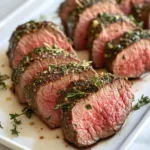
Herb-Crusted Beef Tenderloin (Dinner-Party Star)
This Herb-Crusted Beef Tenderloin is an elegant, flavorful centerpiece perfect for impressing guests with minimal fuss and maximum taste.
Servings: 6 servings
Ingredients
- 2 pounds beef tenderloin
- 2 tablespoons olive oil
- 2 tablespoons Dijon mustard
- 4 cloves garlic minced
- 2 tablespoons fresh rosemary chopped
- 2 tablespoons fresh thyme chopped
- 1 tablespoon fresh parsley chopped
- salt and pepper to taste
- 1 cup beef broth
- 1 tablespoon balsamic vinegar
Instructions
- Start by combining the minced garlic, chopped rosemary, thyme, parsley, salt, and pepper in a small bowl. This fresh herb blend is the secret to the fragrant crust that will coat your tenderloin and infuse every bite with aromatic flavor.
- Pat the beef tenderloin dry with paper towels to ensure a good sear. Rub the olive oil all over the surface of the meat. Season generously with salt and pepper. Heat a large oven-proof skillet over medium-high heat. Once hot, sear the tenderloin on all sides until it develops a golden-brown crust, about 2-3 minutes per side. This locks in the juices and creates a beautiful base for the herb crust.
- Remove the skillet from heat. Using a brush or spoon, spread the Dijon mustard evenly over the seared tenderloin. Then, press the herb mixture onto the mustard-coated beef, making sure it adheres well and covers the entire surface.
- Preheat your oven to 400°F (200°C). Transfer the skillet with the tenderloin into the oven and roast for about 20-25 minutes, or until the internal temperature reaches 130°F (54°C) for medium-rare. Use a meat thermometer for precision. Once done, remove the tenderloin from the oven and tent it loosely with foil. Let it rest for 10-15 minutes to allow the juices to redistribute.
- While the beef rests, place the skillet back on the stovetop over medium heat. Carefully add the beef broth and balsamic vinegar to the pan drippings, scraping up any browned bits with a wooden spoon. Simmer for 5 minutes or until the sauce has reduced slightly and thickened. Adjust seasoning if needed.
- Slice the rested beef tenderloin into thick medallions. Drizzle the pan sauce over the slices or serve it on the side. This dish pairs beautifully with roasted vegetables, creamy mashed potatoes, or a crisp salad.
Equipment
- Large oven-proof skillet
- Meat Thermometer
- Small Bowl
- Wooden Spoon
- Brush or spoon
Notes
- Use a meat thermometer to check doneness for perfect results every time.
- Letting the beef rest after roasting is crucial for juicy, tender slices.
- Fresh herbs make all the difference—avoid dried herbs if possible for maximum flavor.
- If you don’t have an oven-proof skillet, sear the beef in a regular pan then transfer it to a baking dish for roasting.
- For an extra punch of flavor, add a splash of red wine to the pan sauce during reduction.